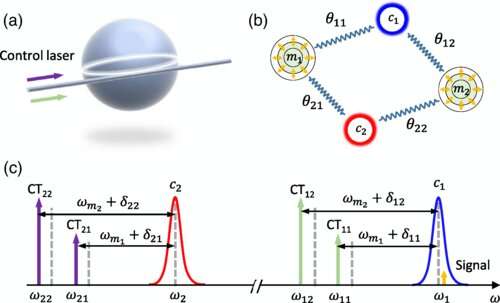This article has been reviewed according to Science X's editorial process and policies. Editors have highlighted the following attributes while ensuring the content's credibility:
fact-checked
peer-reviewed publication
proofread
Researchers achieve nonreciprocal frequency conversion with optical and mechanical modes

Recently, a research team led by Prof. Guo Guangcan from the University of Science and Technology of China (USTC) demonstrated nonreciprocal routing between any two modes with different frequencies through radiation pressure force using two optical modes and two mechanical modes in a microresonator. Their work was published in Physical Review Letters.
Optical and acoustic nonreciprocal devices are important components in information processing and sensing systems based on photons and phonons. Magnetically induced nonreciprocity is widely adopted in optical devices but still faces challenges in device integration. It is difficult to integrate acoustic nonreciprocal devices due to the weak effect of magnetically induced acoustic nonreciprocity. To realize magnet-free nonreciprocity, the optomechanical systems stand out as one of the most promising methods.
In this work, the team studied the nonreciprocal conversion between photons and phonons in a microresonator. The team used two optical modes and two mechanical modes to form a closed loop of a four-mode plaquette, the frequencies of which are 388 THz, 309 THz, 117 MHz, and 79 MHz, respectively. The team demonstrated the nonreciprocal routings between any two nodes among these four modes, including the routing of phonon-phonon (MHz-MHz), photon-photon (THz-THz) and photon-phonon (THz-MHz).
The mechanism of these nonreciprocal conversions is used to construct a synthetic gauge field using multiple modes in an optomechanical microresonator, which is a previous study conducted by the team. The nonreciprocal routing was controlled by adjusting the phase of the gauge field, which was controlled by the phase of the light. Then, by introducing a third mechanical mode into the plaquette, researchers further realized a phononic circulator, the direction of which was controlled by two independent control phases.
The team's results can be generalized to other optical and mechanical modes in microresonators to build hybrid networks with more nodes. This work has great application potential in communication and information processing, especially in optical wavelength-division-multiplexing networks and quantum interface connecting separated systems with incompatible frequencies.
More information: Zhen Shen et al, Nonreciprocal Frequency Conversion and Mode Routing in a Microresonator, Physical Review Letters (2023). DOI: 10.1103/PhysRevLett.130.013601
Journal information: Physical Review Letters
Provided by University of Science and Technology of China




















